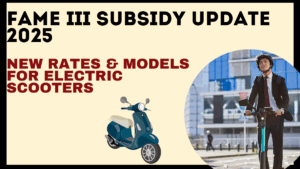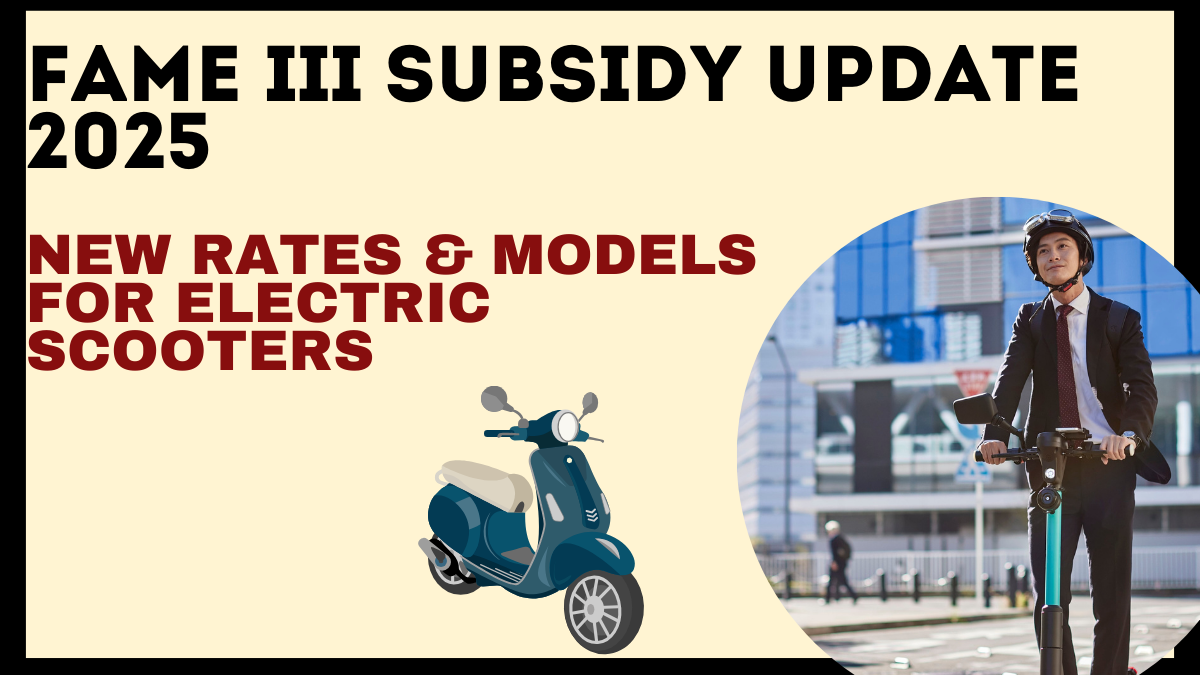The electric scooter market in India has been booming in recent years, thanks to government-backed initiatives under the FAME (Faster Adoption and Manufacturing of Electric Vehicles) scheme. After the success of FAME I and FAME II, the government has rolled out FAME III in 2025, introducing fresh subsidy rules, updated eligibility criteria, and a revised list of models. These new updates are designed to boost adoption, make electric scooters more affordable, and strengthen India’s transition toward sustainable mobility. For buyers planning to switch to EVs, the electric scooter subsidy 2025 update under FAME III is a game-changer.

What is the FAME III Scheme?
The FAME scheme was launched by the Government of India to reduce dependency on fossil fuels and promote electric mobility.
-
FAME I (2015): Focused on early adoption of EVs with small-scale subsidies.
-
FAME II (2019–2024): Expanded subsidies for electric two-wheelers, three-wheelers, and buses.
-
FAME III (2025 onwards): Brings revised subsidy rates, stricter quality checks, and eligibility for a wider range of electric scooters.
The government’s vision with FAME III is not just to encourage EV adoption but also to promote domestic manufacturing, ensuring India remains a key hub in the global EV supply chain.
Key Highlights of the 2025 Electric Scooter Subsidy
The FAME III subsidy update 2025 introduces several critical changes compared to FAME II:
-
Revised Subsidy Rates
-
Subsidy per kWh of battery capacity has been adjusted to make subsidies more uniform across manufacturers.
-
Instead of steep discounts, FAME III offers balanced incentives to prevent misuse and maintain sustainability.
-
-
Cap on Subsidy Amount
-
Maximum subsidy per e-scooter has been revised, ensuring affordable entry-level EVs benefit more while premium luxury EVs receive limited support.
-
-
Eligibility Criteria
-
Only scooters with AIS-156 certified batteries (fire safety compliant) qualify.
-
Models must meet a minimum localization requirement, ensuring Indian parts and batteries are prioritized.
-
-
Focus on Safety and Quality
-
Mandatory fire safety and battery management systems.
-
Compulsory warranties on batteries and motors for all eligible scooters.
-
Impact on Electric Scooter Prices
With the new subsidies:
-
Entry-level scooters will become ₹8,000–₹15,000 cheaper, making them attractive for first-time buyers.
-
Mid-range scooters will see moderate benefits, with final prices dropping by around ₹10,000–₹20,000.
-
Premium scooters (with high battery capacity) may not see a significant price drop, as subsidies are capped.
For urban commuters, this makes budget-friendly models much more appealing in 2025.
Eligible Electric Scooter Models in 2025
Several popular e-scooters are expected to qualify under FAME III subsidies in 2025:
-
Ola S1 Air – Affordable, lightweight, and designed for city commutes.
-
Ather 450S/450X (localized versions) – Known for quality and smart connectivity.
-
Bajaj Chetak Electric (2025 update) – Classic design with modern EV efficiency.
-
TVS iQube Electric – Practical, family-friendly e-scooter.
-
Hero Vida V1 – Hero MotoCorp’s contribution to the EV space, now more affordable under FAME III.
Benefits for Buyers in 2025
-
Lower Purchase Cost: Revised subsidies make scooters more affordable.
-
Reduced Running Expenses: EVs cost ₹0.15–₹0.20 per km, much cheaper than petrol two-wheelers.
-
Government Backing: Extended scheme ensures EVs remain a priority.
-
Better Safety: New rules require fire-proof and safer batteries.
-
Higher Resale Value: Subsidized scooters may retain better resale prices in urban markets.
Challenges Despite Subsidies
-
Charging Infrastructure Gaps: Rural areas still lack widespread charging points.
-
Battery Replacement Costs: Despite subsidies, long-term ownership costs remain a concern.
-
Awareness Issues: Many first-time buyers are still hesitant about EV technology.
-
Limited Range Anxiety: Budget scooters may still offer lower ranges compared to petrol counterparts.
Future of Electric Scooters Under FAME III
With FAME III, the government hopes to:
-
Increase EV two-wheeler penetration from 6% in 2024 to 15–20% by 2026.
-
Encourage manufacturers to localize production and reduce imports.
-
Strengthen India’s EV ecosystem with a long-term vision of phasing out petrol two-wheelers gradually.
FAQs
What is the new subsidy amount for electric scooters in 2025?
Under FAME III, subsidies have been revised to balance affordability. Entry-level scooters may get ₹8,000–₹15,000 benefits.
Which scooters are eligible under FAME III in 2025?
Popular models like Ola S1 Air, Ather 450X, Bajaj Chetak, TVS iQube, and Hero Vida V1 are expected to qualify under updated rules.
Will premium e-scooters get subsidies under FAME III?
Yes, but with limited benefits, as subsidy caps restrict high-end scooters from getting large discounts.
Do FAME III subsidies apply across India?
Yes, subsidies are available nationwide, but exact benefits may vary slightly depending on state-level EV policies.
How long will FAME III subsidies last?
The government has extended the scheme until at least 2028, with periodic reviews and adjustments.
Click here to know more,
